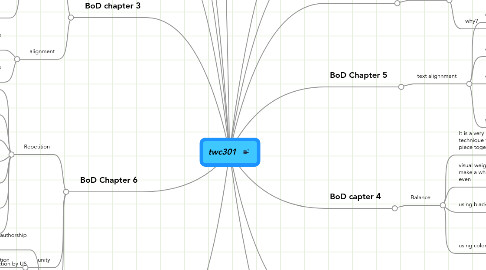
1. class goals
1.1. check on course site every day
1.1.1. keep up with assignments.
1.2. finish asssignments early
1.3. New node
2. i am currently confused about.
2.1. how assignments are being submitted
2.2. is there any way i can check to be sure that i have properly turned in my assignments?
2.2.1. New node
3. course outcomes
3.1. respond appropraitely in different medias of writing
3.2. practice wrinting in multiple genres
3.3. understand different genres
4. critical thinking
4.1. increase critical thinking skills
4.2. integrating beliefs and assumptions
5. BoD chapter 3
5.1. contrast
5.1.1. it is important to make titles bold and contrast with other information.
5.1.1.1. when people are drawn to a title they remeber it better and makes more effective advertising.
5.1.1.2. font, color and size are good contrasting tools to use.
5.1.2. contrast is one of the quickes and most effective ways to draw attention
5.1.2.1. (don"t be afraid to use it)
5.2. alignment
5.2.1. strong alignment helps tie the whole piece together and is less confusing.
5.2.2. important information like telephone numbers should be big and in an obvious place so they are easy to find
6. BoD Chapter 6
6.1. Repetition
6.1.1. repeating some visual aspects of a shape, color, line, etc.
6.1.1.1. EX: bullet points, lines, initial caps.
6.1.2. pages visually organized, conistent, and unified
6.1.3. begnners fail to use enough repetition
6.1.3.1. do not seek all opportunities for repetition
6.1.4. proximity
6.1.4.1. spacial location-close related items are closer together
6.1.5. closure
6.1.5.1. natural tendency to close groups
6.1.6. continuation
6.1.6.1. eye seeks relationships: eye follows line, curve, sequence of shapes.
6.1.7. similarity
6.2. unity
6.2.1. achieved by repetition
6.2.1.1. the human eye seeks unity- everything looks like it belongs together
6.2.1.1.1. easier to read
6.2.1.2. group similarities
6.3. New node
7. Copyright/Fair use/Creative Commons
7.1. original works of authorship are protected
7.1.1. does not protect facts, ideas, systems, methods of operation
7.2. form of protection by US constitution
7.2.1. published and unpublished works
7.3. copyright only has to be registered if lawsuit is in order
7.3.1. copyright is sometimes registered so their work is known publically as copyritten
7.4. US copyright is eligable in most countries that we have ties to but not all
7.5. Fair Use
7.5.1. the best way to go about using someone elses original work is to get their permission
7.5.1.1. copyright office cannot give permission to use copyrighted works.
7.6. Creative commons
7.6.1. symbol contains two small C's in a circle instead of one like regular copyright
7.6.2. allows creators to decide what rights to waive or communicate and share.
8. i would like to learn...
8.1. how to use the online programs.
8.2. understand how the different links work
8.3. make sure i am turning everything into the right place.
8.4. New node
9. knowledge
9.1. develope knowledge of multiple genres/media
10. BoD chapter2
10.1. emphasis
10.1.1. techniques for creating emphasis
10.1.1.1. making important things bigger or brighter
10.1.1.2. not too much text because things blend together and get lost
10.1.2. why?
10.1.2.1. adding emphasis makes sure that the reader atleast reads the importand parts of your peice of work.
11. BoD capter 4
11.1. Balance
11.1.1. It is a very imporant general technique that helps tie a whole piece together
11.1.2. visual weights are supposed to make a whole page visually even
11.1.3. using black and white only
11.1.3.1. using black and white the correct way can still create an impact and is usually cheaper as well.
11.1.4. using color
11.1.4.1. appropriately and effectively use color, to create a balance of the page.
11.1.4.2. appropriate colors are important
12. BoD Chapter 5
12.1. text alighnment
12.1.1. runaround text alignment
12.1.1.1. text wrap- the text wraps around an image or other object.
12.1.2. asymmetric text alignment
12.1.2.1. visually interesting difficult to read
12.1.2.2. better with short lines of text
12.1.2.2.1. EX: magazines
12.1.3. concrete text alignment
12.1.3.1. hard to read visually interesting
12.1.4. grid structure
12.1.4.1. multiple page documents
12.1.4.2. one to seven colomb grids
12.1.4.3. the grid structures help create a layout for a page and keep information organized. can be flexible and still keep things organized.
13. BoD Chapter 1
13.1. before you begin
13.1.1. visual elements
13.1.1.1. deciding what you want to say and what visual elements you want to include is an important first step
13.1.2. layout
13.1.2.1. placement of the visual elements on the page.
13.1.2.1.1. determine what is required in the whole piece and begin designing the layout
13.1.3. audience
13.1.3.1. determining who your audience is is an important thing to do before you start your design.
13.1.3.1.1. figure out what speaks to them, try putting yourself in their position.
14. BoD chapter 7
14.1. flow
14.1.1. leads the reader from one element to the other visually.
14.1.1.1. New node
14.1.2. verbal
14.1.2.1. how text is arranged on the page.
14.1.2.2. order in which the reader reads material on the page.
14.1.2.3. consistency is important, as well as a logical reading path.
14.1.3. visual
14.1.3.1. order that viewer looks at images on the page.
14.1.3.2. determined by the placement and direction the picture is places
